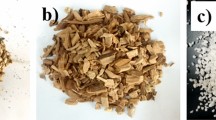Abstract
For this study, an intercalation compounding method was used to prepare Chinese fir wood/Ca-montmorillonite (Ca-MMT) composite board to improve its properties such as surface mechanical properties, flame retardance and dimensional stability. By virtue of water-soluble phenolic resin (PF), Chinese fir wood and Ca-MMT were mixed by pressure and vacuum impregnation. The optimum impregnation technology of Chinese fir wood/Ca-MMT composite board was obtained by using an orthogonal design and a single factor design of pressure and vacuum impregnation, using weight percent gain (WPG) as the basic index. The results are as follows: 1) On the basis of the orthogonal design and an actual experiment, the optimum preparation technology of Chinese fir wood/Ca-MMT composite board is 20% PF resin dispersion concentration (wt%), 1.0 CEC amount of organic intercalation agent, 0.098 MPa vacuum degree, 5% concentration of Ca-MMT and 1.0 MPa pressure. 2) The WPG of the composite board samples of 450 mm length was much larger than that of the samples of 600, 750 and 900 mm length. Warm water extraction contributed little to WPG.
Similar content being viewed by others
References
Chen D. 1997. Chinese fir wood modification with PVA & MF vacuum-pressure impregnating treatment. China Wood Ind, 11(5): 9–13 (in Chinese with English abstract)
Fu Y L, Zhao G J. 2006. Microstructure of wood/silicon dioxide composite. J Beijing For Univ, 28(5): 119–124 (in Chinese with English abstract)
Lv W H, Zhao G J. 2004. Design of wood/montmorillonite intercalation nano-composite. For Stud China, 6(1): 54–62
Lv W H, Zhao G J. 2007. Structure and characterization of Cunninghamia lanceolata wood-MMT intercalation nanocomposite (WMNC). J Beijing For Univ, 29(1): 131–135 (in Chinese with English abstract)
Miyafuji H, Saka S, Yamamoto A. 1998. SiO2-P2O5-B2O3 wood-inorganic composite prepared by metal alkoxide oligomers and their fire-resisting properties. Holzforschung, 52:410–416
Miyafuji H, Saka S. 1997. Fire-resisting properties in several TiO2 wood-inorganic composites and their topochemistry. Wood Sci Tech, 31(6): 449–455
Ogiso K, Saka S. 1994. Wood-inorganic composite prepared by sol-gel process IV. Effects of chemical bonds between wood and inorganic substances on property enhancement. Mokuzai Gakkaishi, 40(10): 1100–1106
Qiu J, Li J. 2005. Preparation of wood-silica aerogels composites by supercritical drying technique and its nano-structure. J Northeast For Univ, 33(3): 3–4 (in Chinese with English abstract)
Saka S, Sasaki M, Tanahashi M. 1992. Wood-inorganic composite prepared by Sol-Gel processing I. wood-inorganic composite with porous structure. Mokuzai Gakkaishi, 38(11):1043–1049
Saka S, Tanno F. 1996. Wood-inorganic composites prepared by the sol-gel process VI. Effects of a property-enhancer on fire-resistance in and wood-inorganic composites. Mokuzai Gakkaishi, 42(1): 81–86
Saka S, Yakake Y. 1993. Wood-inorganic composite prepared by Sol-Gel process III. chemically modified wood-inorganic composite. Mokuzai Gakkaishi, 39(3): 308–314
Wang X C, Cheng Z Q, Mo X H, Tian J, Cao W. 1998. Interface characterization for the in situ Wood/silicon dioxide composites. Mater Eng, 5: 16–18 (in Chinese with English abstract)
Wang X C, Shi S L, Cheng Z Q, Hou H M, Mo X H, Tian J. 2000. Synthesis of (Si-, Al-) ceramic wood by chemical process. China J Mater Res, 14(1): 51–55 (in Chinese with English abstract)
Xue Z H, Zhao G J. 2006. Strain relaxation properties of montmorilonite (MMT)-wood composite. J Beijing For Univ, 28(2): 115–117 (in Chinese with an English abstract)
Zhao G J, Liu S H, Cao J Z. 1999. Technology of surface densification and deforming fixation of China fir (Cunninghamia lanceolata). China Wood Ind, 13(1): 18–22 (in Chinese with English abstract)
Zhao G J. 2002. Nano-dimensions in wood, nano-wood, wood and inorganic nano-composites. J Beijing For Univ, 24(5/6):204–207
Author information
Authors and Affiliations
Corresponding author
Rights and permissions
About this article
Cite this article
Xue, Fl., Zhao, Gj. Optimum preparation technology for Chinese fir wood/Ca-montmorillonite (Ca-MMT) composite board. For. Stud. China 10, 199–204 (2008). https://doi.org/10.1007/s11632-008-0039-1
Received:
Accepted:
Published:
Issue Date:
DOI: https://doi.org/10.1007/s11632-008-0039-1




